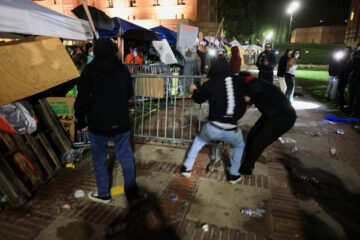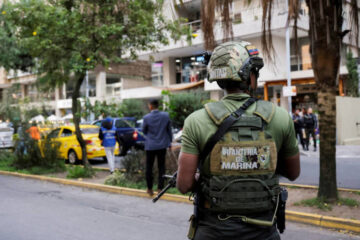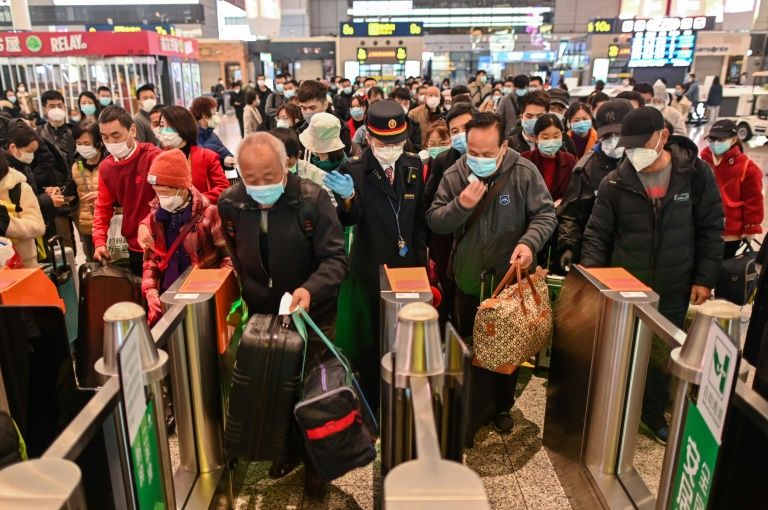Hong Kong democracy protesters defy tear gas, baton charge in historic standoff
Reuters
Riot police advanced on Hong Kong democracy protesters in the early hours of Monday, firing volleys of tear gas after launching a baton-charge in the worst unrest there since China took back control of the former British colony two decades ago.
Some protesters erected barricades to block security forces amid chaotic scenes still unfolding just hours before one of the world\’s major financial centers was due to open for business. Many roads leading to the Central business district remained sealed off as thousands defied police calls to retreat.
Earlier, police baton-charged a crowd blocking a key road in the government district in defiance of official warnings that the demonstrations were illegal.
Several scuffles broke out between police in helmets, gas masks and riot gear, with demonstrators angered by the firing of tear gas, last used in Hong Kong in 2005.
"If today I don\’t stand up, I will hate myself in future," said taxi driver Edward Yeung, 55, as he swore at police on the frontline. "Even if I get a criminal record it will be a glorious one."
White clouds of gas wafting between some of the world\’s most valuable office towers and shopping malls underscored the struggle that China\’s Communist Party faces in stamping its will on Hong Kong\’s more than 7 million people.
China took back control of Hong Kong from Britain in 1997.
Eight years earlier, Beijing\’s bloody crackdown on pro-democracy students in Tiananmen Square in 1989 had sent shockwaves through Hong Kong as people saw how far China\’s rulers would go to maintain their grip on power.
Thousands of protesters were still milling around the main Hong Kong government building, ignoring messages from student and pro-democracy leaders to retreat for fear that the police might fire rubber bullets.
Australia and Italy issued travel warnings for Hong Kong, urging their citizens to avoid protest sites. Some financial firms in the business district advised staff to work from home or from another location.
The U.S. State Department said in a statement on Sunday that Washington supported Hong Kong’s well-established traditions and fundamental freedoms, such as peaceful assembly and expression.
The protests fanned out to the busy shopping district of Causeway Bay and across the harbor to Mong Kok, posing a greater challenge for authorities to contain, local media reported. The protesters brought traffic to a halt and called on Hong Kong leader Leung Chun-ying to step down.
Police, in lines five deep in places, earlier used pepper spray against activists and shot tear gas into the air. The crowds fled several hundred yards (meters), scattering their umbrellas and hurling abuse at police they called "cowards".
Britain returned Hong Kong to Chinese rule under a formula known as "one country, two systems" that guaranteed a high degree of autonomy and freedoms not enjoyed in mainland China. Universal suffrage was set as an eventual goal.
But Beijing last month rejected demands for people to freely choose the city\’s next leader, prompting threats from activists to shut down the Central business district. China wants to limit elections to a handful of candidates loyal to Beijing.
Communist Party leaders in Beijing are concerned that calls for democracy could spread to cities on the mainland.
In a move certain to unnerve authorities in Beijing, media in Taiwan reported that student leaders there had occupied the lobby of Hong Kong\’s representative office on the island in a show of support for the democracy protesters.
Hong Kong leader Leung had earlier pledged "resolute" action against the protest movement, known as Occupy Central with Love and Peace.
"The police are determined to handle the situation appropriately in accordance with the law," Leung said, less than two hours before the police charge began.
Hong Kong police use pepper spray on demonstratorsPlay videoHong Kong police use pepper spray on demonstrators
Police had not used tear gas in Hong Kong since breaking up protests by South Korean farmers against the World Trade Organisation in 2005.
"We will fight until the end … we will never give up," said Peter Poon, a protester in his 20s, adding that he may have to retreat temporarily during the night.
Police denied rumors that they had used rubber bullets.
A spokesperson for China\’s Hong Kong and Macau Affairs Office said the central government fully supported Hong Kong\’s handling of the situation "in accordance with the law".
Such dissent would never be tolerated on the mainland, where the phrase "Occupy Central" was blocked on Sunday on Weibo, China\’s version of Twitter. It had been allowed earlier in the day.
A tearful Occupy organizer, Benny Tai, said he was proud of people\’s determination to fight for "genuine" universal suffrage, but that the situation was getting out of control, local broadcaster RTHK reported. He said he believed he would face heavy punishment for initiating the movement.
Protesters huddled in plastic capes, masks and goggles as they braced for a fresh police attempt to clear them from the financial district before Hong Kong re-opens for business. The city\’s financial markets are expected to open as usual on Monday.
Publishing tycoon Jimmy Lai, a key backer of the democracy movement, joined the protesters.
"The more Hong Kong citizens come, the more unlikely the police can clear up the place," said Lai, also wearing a plastic cape and protective glasses. "Even if we get beaten up, we cannot fight back. We will win this war with love and peace."
Pro-democracy Hong Kong lawmaker Lee Cheuk-yan said three fellow legislators were among a small group of activists detained by police, including democratic leaders Albert Ho and Emily Lau.
Organizers said as many as 80,000 people thronged the streets in Admiralty district, galvanized by the arrests of student activists on Friday. No independent estimate of the crowd numbers was available.
A week of protests escalated into violence when student-led demonstrators broke through a cordon late on Friday and scaled a fence to invade the city\’s main government compound.
Police used pepper spray to disperse the crowd. The Hong Kong Federation of Students has extended class boycotts indefinitely and called on the city\’s leader to step down.
Police have so far arrested 78 people, including Joshua Wong, the 17-year-old leader of student group Scholarism, who was dragged away after calling on protesters to charge the government premises.
Wong was released without charge on Sunday night. He told reporters he planned to return to the protest site after resting. Student leaders Alex Chow and Lester Shum have also been released.
Source: Reuters
[do_widget_area inner_adsbar]









